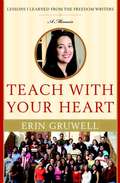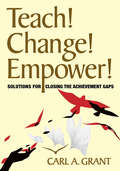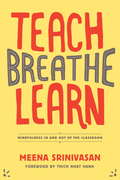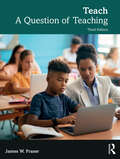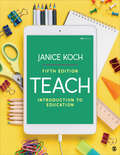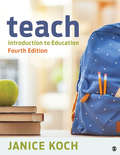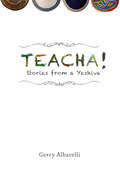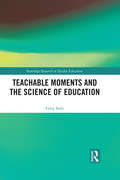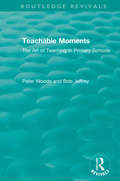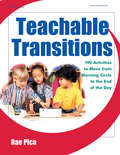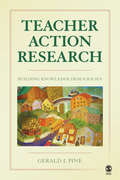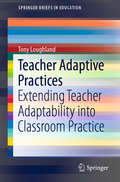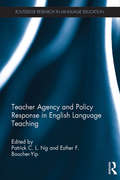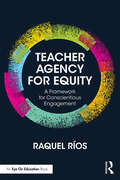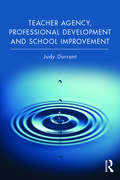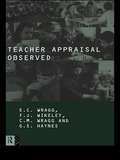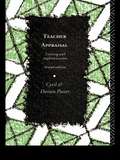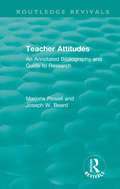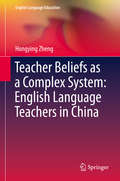- Table View
- List View
Teach with Your Heart: Lessons I Learned from the Freedom Writers
by Erin GruwellIn this memoir and call to arms, Erin Gruwell, the dynamic young teacher who nurtured a remarkable group of high school students from Long Beach, California, who called themselves the Freedom Writers, picks up where The Freedom Writers Diary(and the movie The Freedom Writers) end and catches the reader up to where they are today. Teach with Your Heart will include the Freedom Writers' unforgettable trip to Auschwitz, where they met with Holocaust survivors.
Teach! Change! Empower!: Solutions for Closing the Achievement Gaps
by Carl A. Grant"Teach! Change! Empower! takes the concepts of diversity and change—which are often complex, abstract, confusing, and not salient to many teachers who struggle with the meaning of these concepts in actual classroom practices—and uses them as a framework for something that is very real to teachers: the achievement gap."—Barbara Heuberger Rose, Associate ProfessorMiami University"Readers are challenged to think about themselves and their role in addressing achievement gaps in a non-blaming manner. Carl Grant does an outstanding job of incorporating the work of a number of researchers."—Maria Whittemore, Minority Achievement CoordinatorFrederick County Public Schools, MDNarrow the achievement gap by affirming diversity and engaging in a process of personal change!The achievement gap illustrates restricted life chances and choices for many students, and only by addressing these inequities can we enable all learners to reach their fullest potential. Teach! Change! Empower! provides a powerful, step-by-step process for making the changes necessary to close the achievement gaps in your school!This innovative resource offers a wealth of strategies and action plans to help teachers reflect on their own beliefs about diversity and power and turn those reflections into actions. Educators can put into practice ideas that challenge the status quo, including:Culturally relevant curriculum and environments for studentsCaring with a social-political consciousness within a culture of learningCooperative professional development for teachers, administrators, and staffDemocratic student involvementInitiate change in your classroom that fosters lifelong learning in yourself, your students, and your school!
Teach, Breathe, Learn: Mindfulness in and out of the Classroom
by Meena SrinivasanIn Teach, Breathe, Learn, Meena Srinivasan highlights how mindfulness can be an effective tool in the classroom. What makes this book truly unique is her perspective as a classroom teacher, wrestling daily with the conditions about which she writes. <P> <P> "Teach, Breathe, Learn provides accessible, practical application of mindfulness to overcome challenges faced during the school day." Testimonials from students and colleagues are woven throughout the book. Teach, Breathe, Learn is designed for educators at all levels, parents interested in sharing mindfulness with their children, and anyone curious about how to cultivate their own mindfulness practice and eventually teach mindfulness to others.Part 1 helps teachers develop compassion and shift from "reacting" to "responding" to demands.Part 2 offers techniques for cultivating loving-kindness, gratitude and seeing students, colleagues, and parents as oneself.The last section of the book introduces a curriculum teachers can use to incorporate mindfulness into their classroom, replete with lesson plans, handouts, and homework assignments.
Teach: A Question of Teaching
by James W. FraserIs teaching for me? Who will I teach? How can I make a difference? Teach is a vibrant and engaging Introduction to Education textbook, organized around real questions students ask themselves and their professors as they consider a career in teaching. Using vivid and contemporary examples, veteran teacher educator James W. Fraser continually encourages readers to reflect on their experiences and engage in a dialogue about the most current issues in education. The thoroughly updated third edition includes fully rewritten chapters, including one discussing the current debates about classroom discussions of race and sexuality and the impact of the COVID-19 pandemic on schools and another on today’s newest technologies and their impact on teachers and schools. In each chapter, newly selected primary source readings provide students with the latest in education-related scholarship and integrates the intellectual foundations of education throughout each chapter, offering scholarly and current content in a student-friendly format. Features and updates include: • In a new, thoroughly revised and up-to-date but also much more compact version, the third edition of the popular Teach textbook for basic courses in a teacher education program invites aspiring teachers and the simply curious to ponder many of the most essential questions of what a career in teaching might look like in the next decades of the 21st century. • Up-to-date coverage of new legislation and school policies that impact teachers including debates about discussions on race and Critical Race Theory, sexuality and the importance of LGBTQ+ history and current rights that influence curricula, school policies, and teachers' free-speech rights, with particular emphasis on the declining role of the Common Core State Standards. • A completely rewritten Chapter 8 offers an up-to-the-minute overview of how technology can help improve and challenge teachers and teaching. • Features such as “Teachable Moment” and “Notes from the Field” encourage readers—through a variety of prompts and exercises—to reflect on their own educational experiences and goals, and challenge prospective teachers to imagine themselves in similar situations. • Short chapters and digestible sections provide an approach and format to reach students without compromising on high-quality content. • The concluding chapter explores the question, “Where do I go from here?” to help prospective teachers develop a plan for their career and design a personal philosophy to guide them. Teach presents an overview of the field in a way sure to keep students reading and gives those with questions about teaching the tools and information they need to continue a rich dialogue about their possible careers.
Teach: Introduction to Education
by Janice KochThe fifth edition of the best-selling Teach by Janice Koch aims to help students answer the question, "Is teaching the right career for me?" Via a concise but wide-ranging exploration of the American public education system, Teach asks readers to imagine themselves in the classroom and develop their own ideas of what it means to be a teacher. Real-life classroom stories from teachers themselves help readers see themselves as teachers. Chapters feature the latest edTPA and InTasc Standards to structure learning, as well as learning outcomes and journal prompts to give readers clear goals and ways to build their teaching skills. This new edition features major emerging issues in education, including developments in technology in the classroom, with both positive and negative implications; more on the STEM, STEAM, and maker movements; school choice and homeschooling; sexual orientation and gender identity; diversity, equity, and inclusion; and the importance of personal wellness in teacher success. Throughout the text, the author references and contextualizes the effects of the COVID-19 pandemic, where appropriate, to reflect the ways students, teachers, and classrooms have been altered by this historic event. Combining historical and contemporary perspectives, this text helps future teachers examine the ways in which society and culture shape schools and the ways in which schools shape society and culture.
Teach: Introduction to Education
by Janice KochThe fifth edition of the best-selling Teach by Janice Koch aims to help students answer the question, "Is teaching the right career for me?" Via a concise but wide-ranging exploration of the American public education system, Teach asks readers to imagine themselves in the classroom and develop their own ideas of what it means to be a teacher. Real-life classroom stories from teachers themselves help readers see themselves as teachers. Chapters feature the latest edTPA and InTasc Standards to structure learning, as well as learning outcomes and journal prompts to give readers clear goals and ways to build their teaching skills. This new edition features major emerging issues in education, including developments in technology in the classroom, with both positive and negative implications; more on the STEM, STEAM, and maker movements; school choice and homeschooling; sexual orientation and gender identity; diversity, equity, and inclusion; and the importance of personal wellness in teacher success. Throughout the text, the author references and contextualizes the effects of the COVID-19 pandemic, where appropriate, to reflect the ways students, teachers, and classrooms have been altered by this historic event. Combining historical and contemporary perspectives, this text helps future teachers examine the ways in which society and culture shape schools and the ways in which schools shape society and culture.
Teach: Introduction to Education (New, Engaging Titles From 4ltr Press Series)
by Dr Janice KochTeach is a concise introduction to education that challenges readers’ preconceived notions of teaching in order to transform them into reflective practitioners. Empathizing with the difficulties students face as they move from the college classroom to their own classrooms, revered author Janice Koch invites readers to both reflect on their own dispositions for teaching and look outside of themselves to the demands of the profession, making the philosophy of teaching and learning accessible and relevant. The Fourth Edition emphasizes the changing student population and the role of technology and globalization in the field, while also including the Interstate Teacher Assessment and Support Consortium (InTASC) standards correlating with each chapter’s content. With the guidance of this supportive text, readers will gain vital exposure by engaging with professional standards from the very start of their career.
Teach: Introduction to Education (New, Engaging Titles From 4ltr Press Series)
by Dr Janice KochTeach is a concise introduction to education that challenges readers’ preconceived notions of teaching in order to transform them into reflective practitioners. Empathizing with the difficulties students face as they move from the college classroom to their own classrooms, revered author Janice Koch invites readers to both reflect on their own dispositions for teaching and look outside of themselves to the demands of the profession, making the philosophy of teaching and learning accessible and relevant. The Fourth Edition emphasizes the changing student population and the role of technology and globalization in the field, while also including the Interstate Teacher Assessment and Support Consortium (InTASC) standards correlating with each chapter’s content. With the guidance of this supportive text, readers will gain vital exposure by engaging with professional standards from the very start of their career.
Teacha!
by Gerry AlbarelliGerry Albarelli's TEACHA! STORIES FROM A YESHIVA chronicls a year in the life of a non-Jewish teacher and his students at a wild Hasidic yeshiva in Brooklyn.
Teachability and Learnability: Can Thinking Be Taught? (Routledge International Studies in the Philosophy of Education #40)
by Paul FairfieldDeep disagreements exist regarding what thinking and critical thinking are and to what extent they are teachable. Thinking is learned in some measure by all, but not everything that is learnable is also teachable in an institutional setting. In questioning the relationship between teachability and learnability, Fairfield investigates the implications of thinking as inquiry, education as the cultivation of agency, and self-education. By challenging some of the standard conceptions of thinking, the author explores the limits of teachability and advances critiques of standardized tests, digital learning technologies, and managerialism in education.
Teachable Moments and the Science of Education (Routledge Research in Teacher Education)
by Greg SealsThis book develops a general theory of autonomous teaching by examining a mysterious educational idea: the teachable moment. By formulating an understanding of the teachable moment as predicated upon ‘educational energy,’ this book takes up John Dewey’s view of teaching to articulate a law-like, scientifically oriented pedagogical theory. By offering a testable hypothesis about effective teaching through an innovative reading of Dewey’s law, this book also provides insights into changes in school practice and schooling policy consonant with an understanding of teaching as a science.
Teachable Moments: The Art of Teaching in Primary Schools (Routledge Revivals)
by Peter Woods Bob JeffreyCreative teaching is an art form – aesthetic, intuitive and expressive. The proliferation of new educational policies in the early 1990s and the related increase in tensions and dilemmas facing schools, combined with the growing demand for a wider range of skills and knowledge among children meant that there was an even greater need for creative teaching than before the National Curriculum. Originally published in 1996, this book addresses this need by: exploring the features of creative teaching with a focus on the day to day practice of primary teachers; showing how teachers used emotion, created atmosphere and stimulated imagination to enhance their teaching; examining the ways in which teachers managed the National Curriculum and developed a new professional discourse in response to government pressures at the time. This book is a sequel to Creative Teachers in Primary Schools and builds upon this work providing new insights into the art of teaching.
Teachable Moments: Theological Reflections from The World’s Most Familiar Prayer
by Johnny WhiteTeachable Moments consists of theological reflections on the world's most familiar prayer taken from the lips of Jesus Himself, repeated on a weekly basis in churches throughout the world. Many who claim the name Christian are captive to a culture that is in subtle if not direct contradiction to the radical implications of this Prayer. Teachable Moments confronts that unhealthy captivity. The radical nature of the Creator God as Abba Father, and what it means to be citizens of God's Kingdom &“on earth as it is in heaven,&” deserves to be taken seriously.Written in a readable and thought-provoking style, Teachable Moments will prompt new thoughts about Jesus&’ radical theology of God as Abba Father. When Jesus taught his disciples this brief prayer, he had an agenda much larger than just words to pray. He was concerned with our understanding of God and the nature of our relationship with God. He was teaching about the nature of Kingdom citizenship on earth as it is in heaven, the nature of forgiveness which breaks the unhealthy cycle of revenge, the nature of temptation and pervasive evil in the world. Jesus&’ goal was to correct and redirect all the wrong-headed misconceptions the world has accumulated about the one true God who He understood as Abba Father. Finally, this provocative book asks the all-important question: What kind of Jesus says and teaches things like these? Who are we following?Teachable Moments is intended for the most faithful person occupying a pew on Sunday morning repeating these familiar words of The LORD&’s Prayer, but also it is for the person who never enters a church but nonetheless knows the words by memory. Adult Bible Study groups will find this book a beneficial curriculum for Bible study and discussion. Pastors will find these theological reflections helpful in sermon preparation on The LORD&’s Prayer.
Teachable Transitions: 190 Activities to Move from Morning Circle to the End of the Day
by Rae PicaAs children pretend to trudge their way through knee-deep marshmallow fluff, or zoom around like a vacuum cleaner, even cleaning up the classroom becomes an enjoyable experience. Thanks to transitions that are both fun and educational, the minutes between planned activities become moments that children actually look forward to. With Teachable Transitions, each and every preschooler will be engaged and interested all day long! Filled with movement activities, games, fingerplays, chants, and songs, Teachable Transitions offers a variety of ways for your preschoolers to move through their day. Organized by categories such as "Arrival," "Outside," "Snacks & Lunch," and "Cleanup," each transition will hold the children's attention as they go from one activity to the next. The "Ready, Set, Go," format turns ordinary, everyday transitions into stress-free learning moments. Transitions include: Moving Like Animals Freeze, Shake, and Clean Tiptoe to Tiptop Shape Get Ready, Spaghetti What's My Shape? Statues and Rag Dolls Tummy to Tummy …and many, many more!
Teacher Action Research: Building Knowledge Democracies
by Gerald J. Pine"This is a wonderful book with deep insight into the relationship between teachers' action and result of student learning. It discusses from different angles impact of action research on student learning in the classroom. Writing samples provided at the back are wonderful examples." —Kejing Liu, Shawnee State UniversityTeacher Action Research: Building Knowledge Democracies focuses on helping schools build knowledge democracies through a process of action research in which teachers, students, and parents collaborate in conducting participatory and caring inquiry in the classroom, school, and community. Author Gerald J. Pine examines historical origins, the rationale for practice-based research, related theoretical and philosophical perspectives, and action research as a paradigm rather than a method.Key FeaturesDiscusses how to build a school research culture through collaborative teacher researchDelineates the role of the professional development school as a venue for constructing a knowledge democracyFocuses on how teacher action research can empower the active and ongoing inclusion of nontraditional voices (those of students and parents) in the research process Includes chapters addressing the concrete practices of observation, reflection, dialogue, writing, and the conduct of action research, as well as examples of teacher action research studies
Teacher Adaptive Practices: Extending Teacher Adaptability into Classroom Practice (SpringerBriefs in Education)
by Tony LoughlandThis book introduces the construct of teacher adaptive practices, extending existing research on teacher adaptability into classroom practices. It identifies specific teaching practices that constitute the just-in-time adaptation during lessons that provides opportunities for students’ critical and creative thinking. 278 classroom observations of teachers resulted in a summary of teaching behaviours that constitute teacher adaptive practices. Based on these findings, the book develops a practical teacher improvement program.
Teacher Agency and Policy Response in English Language Teaching (Routledge Research in Language Education)
by Patrick C. Ng Esther F. Boucher-YipThe role of English in the global arena has prompted official language-in-education policy makers to adopt language education policies to enable its citizens to be proficient in English and to access knowledge. Local educational contexts in different countries have implemented English education in their own ways with different pedagogical goals, motivations, features and pedagogies. While much of the research cited in English language planning policy has focused on macro level language policy and planning, there is an increasing interest in micro planning, in particular teacher agency in policy response. Individual teacher agency is a multifaceted amalgam, not only of teachers’ individual histories, professional training, personal values and instructional beliefs, but also of how these interact with local interpretations and appropriations of policy. Teacher Agency and Policy Response in English Language Teaching examines the agency of the teacher in negotiating educational reforms and policy changes at the local and national levels. Chapters in the book include: English language teaching in China: teacher agency in response to curricular innovations Incorporating academic skills into EFL curriculum: teacher agency in response to global mobility challenge Teacher agency, the native/nonnative dichotomy, and "English Classes in English" in Japanese high Schools Teacher-designed high stakes English language testing: washback and impact This book will appeal to researcher across all sectors of education, in particular key stakeholders in curriculum and language planning. Those interested in the latest development of English language teaching will also find this book a valuable resource.
Teacher Agency for Equity: A Framework for Conscientious Engagement
by Raquel RíosThis book provides educators with a conceptual framework to explore and develop authenticity and agency for equity. In response to growing cynicism within the field of education, Raquel Ríos argues that in order to become authentic agents of change, teachers must take a stance of mindful inquiry and examine the role of a teacher within the broader socio-political context. By utilizing the six principles of Conscientious Engagement, teachers can expand their awareness of the power of language and thought, the complex nature our professional relationships, and how we channel energy in ways that can impede or strengthen our work for equity. Full of real-world stories and input from practitioners in the field, this book helps teachers of all levels develop the skills and confidence to grapple with tough philosophical and ethical questions related to social justice and equity, such as: What is poverty consciousness and what responsibility do we owe students who come from poorer communities? How does racist ideology impact our thinking and practice in education? How can we tap into an evolutionary consciousness and collective purpose in order to transform how we advocate for equity? How can we expand our professional network for the integration of new ideas? How can teachers really make a difference that matters, a difference that extends beyond the four walls of the classroom?
Teacher Agency, Professional Development and School Improvement
by Judy DurrantHighlighting the role of teachers in school change, Teacher Agency, Professional Development and School Improvement explores the important related issues of professional identity, teacher self-efficacy, leadership and autonomy in the context of contested improvement agendas. Providing analytical frameworks and practical models, this book: Offers examples of projects, programmes and narratives to illustrate the role of teachers in school change Invites readers to reconceptualise professional development and re-imagine school improvement Focuses on enabling teacher agency as the foundation for improvement Emphasises the importance of human agency to influence environments, lives and learning Provides strategies for improvement with integrity amidst powerful accountability requirements and external forces for change. At the heart of this book is a fresh perspective on schooling, in which teacher agency is considered a fundamental dimension of professional development and key to school improvement. This raises necessary and challenging questions about purposes and processes in education. With practical ideas and strategies that can be used to inform and evaluate practice and policy, Teacher Agency, Professional Development and School Improvement is essential reading for headteachers and teachers wishing to lead changes to improve their school and for teacher educators who support them.
Teacher Appraisal Observed
by Prof E Wragg E. C. Wragg G. Haynes Felicity WikelySystems for the appraisal of teachers have been in place since 1992, bringing with them considerable controversy. How effective are they? What does this mean for the classroom teacher? This major new study, led by Ted Wragg, uses as its basis information gathered from all 109 Local Education authorities, 658 primary and secondary teachers and 479 appraisers. Teacher appraisal is examined from the perspectives of all those concerned and at all levels. The main focus of the study is on teacher competence in the classroom, which lies at the heart of school effectiveness and improving pupils' achievement. Through the use of a variety of methods including intensive case studies, the book provides a unique insight into the quality of classroom practice and teacher appraisal today, what it means for those involved and how to use this knowledge to move on from this point.
Teacher Appraisal: Training and Implementation
by Cyril Poster Doreen PosterThis second edition of the Posters' highly successful guide to teacher appraisal has been substantially updated to include the definitive Department For Education (DFE) regulations and guidelines which have appeared since the publication of the first edition. The book includes two completely new chapters, on the new regulations as they affect grant-maintained schools and on developments in Northern Ireland and Scotland. The authors have orientated their work much more to schools, providing updated versions of their valuable training materials for school-based INSET, group work and self-study. This second edition also includes research evidence from trials of headteachers' appraisal.
Teacher As Stranger: Educational Psychology for the Modern Age
by Maxine GreeneTeacher as Stranger" is for the teacher or teacher-to-be as a detailed philosophical look at teaching and education through essays examining: "Being and Learning", "Knowledge: Science and Subjectivity", "Approaches to Truth and Belief", "Moral Dilemmas and Commitments", etc.
Teacher Attitudes: An Annotated Bibliography and Guide to Research (Routledge Revivals)
by Marjorie Powell Joseph W. BeardTeachers’ attitudes have been a subject of study and interest for many years. Originally published in 1986, this bibliography attempts to review the large field of research between the years 1965 and 1984. To identify all the sources of information, and to list documents that discuss research on teachers’ attitudes. It does not include an assessment of the quality of the research reported in the listed documents, however, the value is in its comprehensiveness. Users of the bibliography can locate the listed studies and then evaluate the studies using criteria relevant to their individual purposes.
Teacher Awareness as Professional Development: Assistant Language Teachers in a Cross-Cultural Context
by Nami SakamotoThis book examines the process of identity (re)construction for assistant language teachers (ALTs) in foreign language classrooms in Japan, using Narrative Inquiry as a tool to provide a multifaceted perspective on their personal and professional growth. To develop a thorough understanding of the classroom, the author proposes three different types of awareness from the perspective of sociocultural theory. Each type of awareness is a unique lens through which to see the teachers’ world of language teaching within the classroom. Finally, the book discusses teacher development, teaching theory, and identity based on analysis of the narrative data. The book offers useful pedagogical insights that may have implications for teacher development and principles of language team teaching for teachers, teacher trainers, ALTs, boards of education, and university students of English and language education, including English as a Foreign Language (EFL).
Teacher Beliefs as a Complex System: English Language Teachers in China
by Hongying ZhengThe volume is a practical introduction to the ways in which the teachers deal with classroom events in the context of change for researchers, teachers, administrators who wish to implement curriculum reform to EFL in schools. The author provides insights into the beliefs of Chinese teachers of English as a Foreign Language (EFL), and their pedagogical choices in the context of the National English Curriculum Reform. The complex nature of EFL teachers' beliefs about EFL teaching and learning are exposed, how their beliefs interact with mental and actionable processes triggered by classroom practice, and how their beliefs co-adapt with contexts to maintain the stability of the teachers' belief systems. This is the first study to present complexity theory in a narrative context of education, exploring the non-linear and unpredictable features of the relationship between the teachers' beliefs and practices. Integrating complexity theory with interpretivist, ecological and sociocultural perspectives, this book contributes to the research agenda by providing a systematic framework for examining teacher beliefs as a whole, and examining the extent to which western theory may be applied to Chinese educational contexts.
